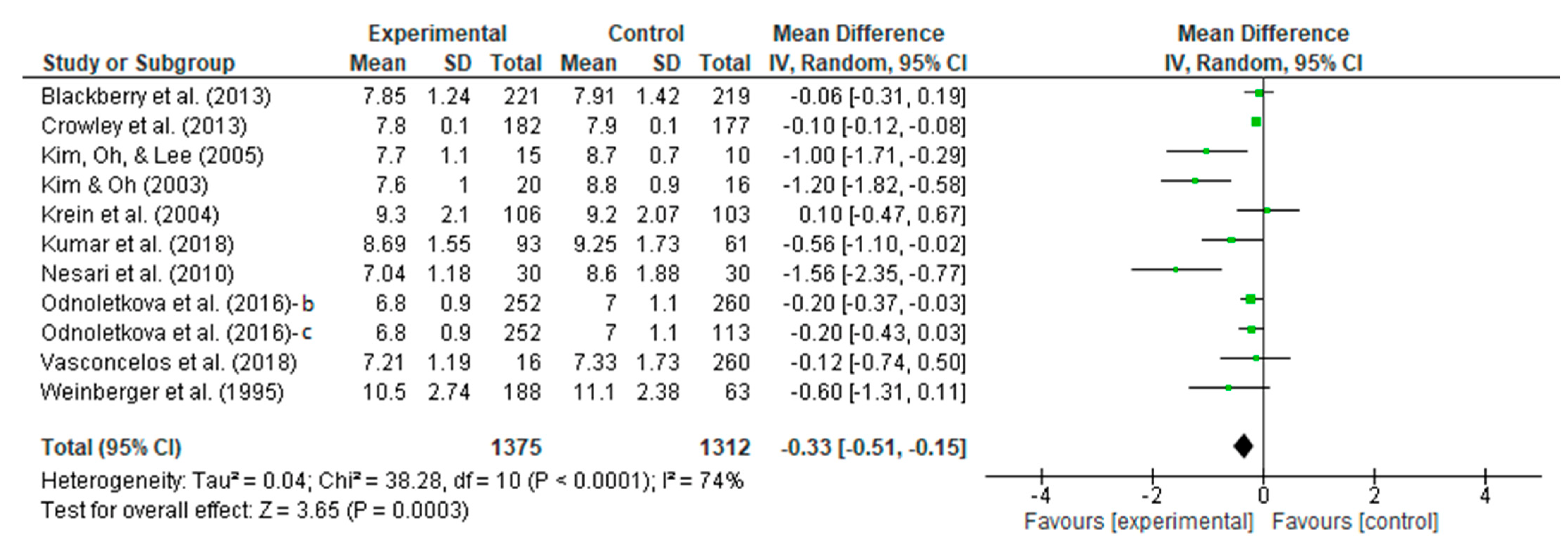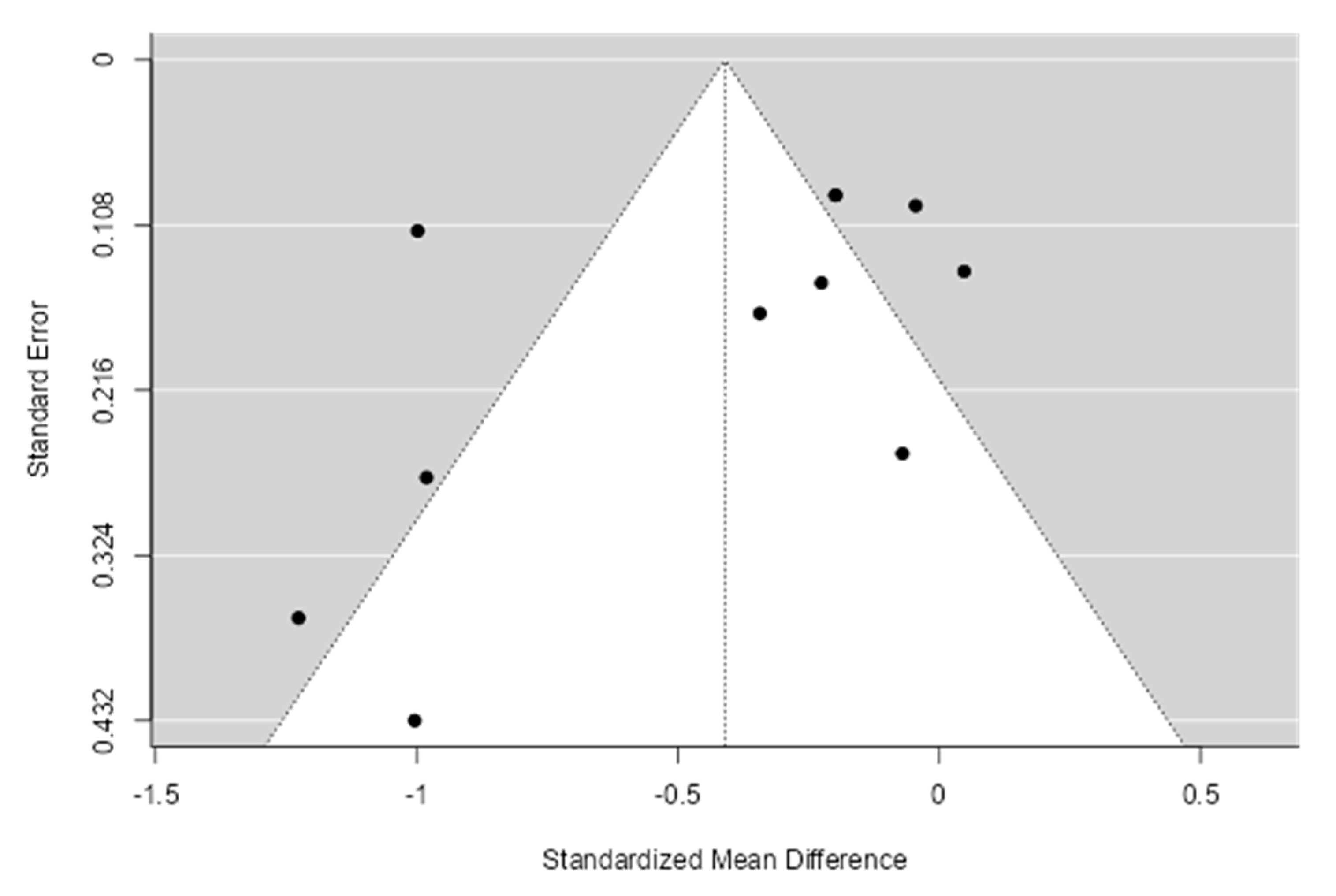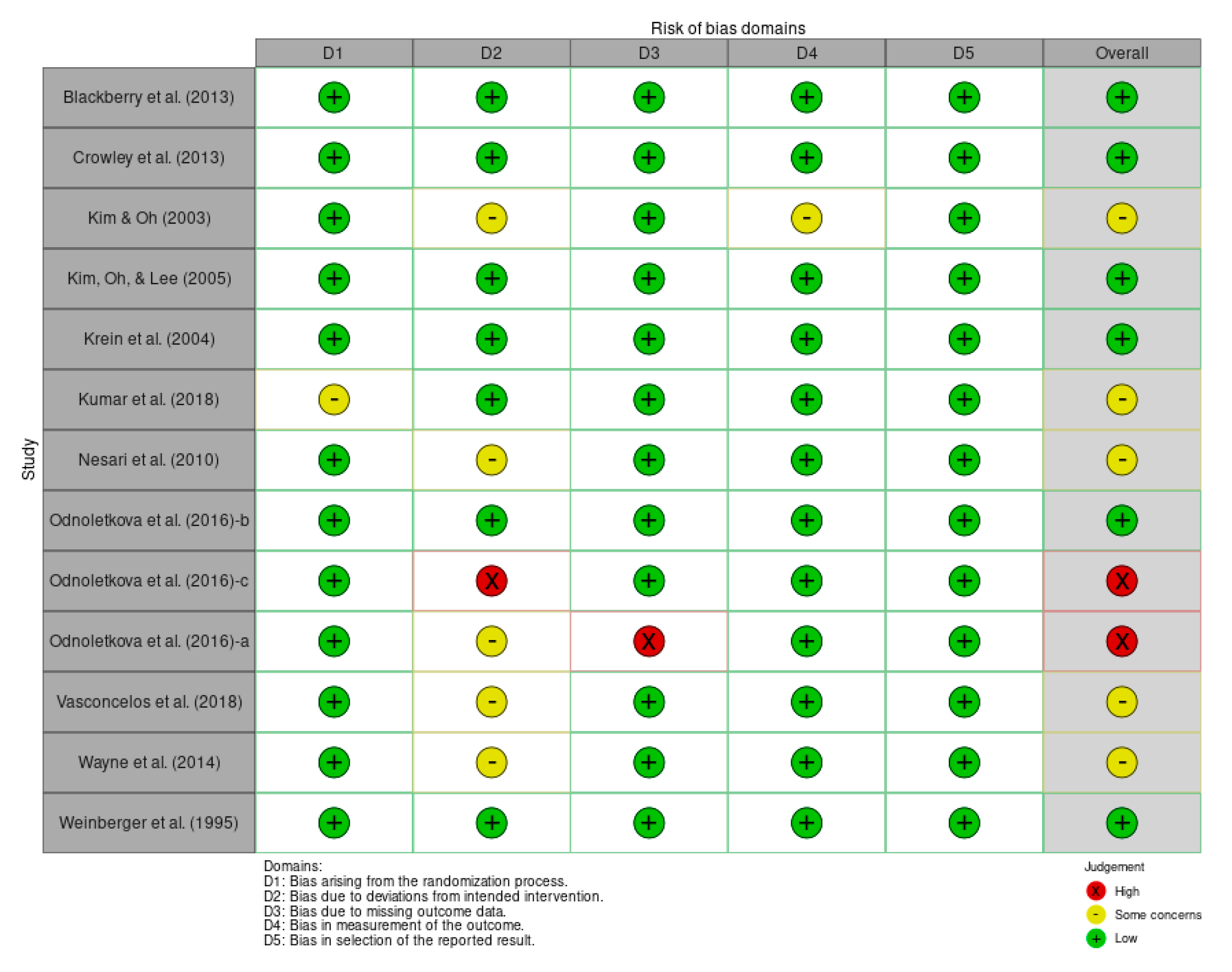Systematic Review and Meta-Analysis of Telecoaching for Self-Care Management among Persons with Type 2 Diabetes Mellitus
Abstract
1. Introduction
2. Methods
2.1. Study Design
2.2. Search Strategy
2.3. Eligibility Criteria
2.4. Data Collection and Analysis
2.5. Quantitative Data Analysis
3. Results
3.1. Selection Study
3.2. Characteristics of Included Studies
3.3. Risk of Bias
3.4. Study Outcome
3.4.1. Model of Telecoaching
3.4.2. Meta-Analysis Outcome of HbA1c Reduction
3.4.3. Meta-Analysis Outcome of Fasting Plasma Glucose Reduction
3.4.4. Meta-Analysis Outcome of Systolic Blood Pressure
3.4.5. Meta-Analysis Outcome of Diastolic Blood Pressure
3.4.6. Meta-Analysis Outcome of Total Cholesterol
3.4.7. Meta-Analysis Outcome of Triglycerides
3.4.8. Meta-Analysis Outcome of HDL
3.4.9. Meta-Analysis Outcome of LDL
3.4.10. Meta-Analysis Outcome of Weight
3.4.11. Meta-Analysis Outcome of BMI
3.4.12. Feasibility and Adherence to a Healthy Lifestyle
3.4.13. Cost-Effectiveness Outcome
4. Discussion
5. Conclusions
Author Contributions
Funding
Informed Consent Statement
Data Availability Statement
Conflicts of Interest
References
- World Health Organization. COVID 19 Public Health Emergency of International Concern (PHEIC) Global Research and Innovation Forum: Towards a Research Roadmap. Glob. Res. Collab. Infect. Dis. Prep. 2020, 1–10. Available online: https://www.who.int/publications/m/item/covid-19-public-health-emergency-of-international-concern-(pheic)-global-research-and-innovation-forum (accessed on 13 August 2022).
- CDC. People with Certain Medical Conditions. Available online: https://www.cdc.gov/coronavirus/2019-ncov/need-extra-precautions/people-with-medical-conditions.html (accessed on 13 August 2022).
- Boulton, A. Why access to diabetes care must not be another victim of the COVID-19 pandemic. Diabetes Res. Clin. Pract. 2021, 171, 108657. [Google Scholar] [CrossRef] [PubMed]
- Schulman-Green, D.; Jaser, S.S.; Park, C.; Whittemore, R. A Metasynthesis of Factors Affecting Self-Management of Chronic Illness. J. Adv. Nurs. 2016, 72, 1469–1489. [Google Scholar] [CrossRef] [PubMed]
- Shi, C.; Zhu, H.; Liu, J.; Zhou, J.; Tang, W. Barriers to self-management of type 2 diabetes during COVID-19 medical isolation: A qualitative study. Diabetes Metab. Syndr. Obes. Targets Ther. 2020, 13, 3713–3725. [Google Scholar] [CrossRef] [PubMed]
- Yancy, C.W.; Jessup, M.; Bozkurt, B.; Butler, J.; Casey, D.E.; Drazner, M.H.; Fonarow, G.C.; Geraci, S.A.; Horwich, T.; Januzzi, J.L.; et al. 2013 ACCF/AHA guideline for the management of heart failure: Executive summary: A report of the American college of cardiology foundation/american heart association task force on practice guidelines. J. Am. Coll. Cardiol. 2013, 62, 1495–1539. [Google Scholar] [CrossRef]
- Kumar, S.; Moseson, H.; Uppal, J.; Juusola, J.L. A Diabetes Mobile App With In-App Coaching From a Certified Diabetes Educator Reduces A1C for Individuals With Type 2 Diabetes. Diabetes Educ. 2018, 44, 226–236. [Google Scholar] [CrossRef]
- Page, M.J.; McKenzie, J.E.; Bossuyt, P.M.; Boutron, I.; Hoffmann, T.C.; Mulrow, C.D.; Shamseer, L.; Tetzlaff, J.M.; Akl, E.A.; Brennan, S.E.; et al. The PRISMA 2020 statement: An updated guideline for reporting systematic reviews. BMJ 2021, 372, n71. [Google Scholar] [CrossRef]
- Riley, R.D.; Moons, K.G.M.; Snell, K.I.E.; Ensor, J.; Hooft, L.; Altman, D.G.; Hayden, J.; Collins, G.S.; Debray, T.P.A. A guide to systematic review and meta-analysis of prognostic factor studies. BMJ 2019, 364, k45897. [Google Scholar] [CrossRef]
- Higgins, J.P.T.; Thompson, S.G.; Deeks, J.J.; Altman, D.G. Measuring inconsistency in meta-analyses. BMJ 2003, 327, 557–560. [Google Scholar] [CrossRef]
- Duval, S.; Tweedie, R. Trim and fill: A simple funnel-plot-based method of testing and adjusting for publication bias in meta-analysis. Biometrics 2000, 56, 455–463. [Google Scholar] [CrossRef]
- Blackberry, I.D.; Furler, J.S.; Best, J.D.; Chondros, P.; Vale, M.; Walker, C.; Dunning, T.; Segal, L.; Dunbar, J.; Audehm, R.; et al. Effectiveness of general practice based, practice nurse led telephone coaching on glycaemic control of type 2 diabetes: The Patient Engagement And Coaching for Health (PEACH) pragmatic cluster randomised controlled trial. BMJ 2013, 347, f5272. [Google Scholar] [CrossRef]
- Crowley, M.J.; Powers, B.J.; Olsen, M.K.; Grubber, J.M.; Koropchak, C.; Rose, C.M.; Gentry, P.; Bowlby, L.; Trujillo, G.; Maciejewski, M.L.; et al. The cholesterol, hypertension, and glucose education (CHANGE) study: Results from a randomized controlled trial in African Americans with diabetes. Am. Heart J. 2013, 166, 179–186.e2. [Google Scholar] [CrossRef] [PubMed]
- Wayne, N.; Ritvo, P. Smartphone-Enabled Health Coach Intervention for People with Diabetes from a Modest Socioeconomic Strata Community: Single-Arm Longitudinal Feasibility Study. J. Med. Internet Res. 2014, 16, e3050. [Google Scholar] [CrossRef] [PubMed]
- Vasconcelos, H.C.A.d.; Neto, J.C.G.L.; Araújo, M.F.M.d.; Carvalho, G.C.N.; de Souza Teixeira, C.R.; Freitas, R.W.J.F.d.; Damasceno, M.M.C. Telecoaching programme for type 2 diabetes control: A randomised clinical trial. Br. J. Nurs. 2018, 27, 1115–1120. [Google Scholar] [CrossRef] [PubMed]
- Kim, H.-S.; Oh, J.-A.; Lee, H.-O. Effects of Nurse-Coordinated Intervention on Patients with Type 2 Diabetes in Korea. J. Nurs. Care Qual. 2005, 20, 154–160. [Google Scholar] [CrossRef] [PubMed]
- Kim, H.-S.; Oh, J.-A. Adherence to Diabetes Control Recommendations: Impact of Nurse Telephone Calls. J. Adv. Nurs. 2003, 44, 256–261. [Google Scholar] [CrossRef]
- Krein, S.L.; Klamerus, M.L.; Vijan, S.; Lee, J.L.; Fitzgerald, J.T.; Pawlow, A.; Reeves, P.; Hayward, R.A. Case management for patients with poorly controlled diabetes: A randomized trial. Am. J. Med. 2004, 116, 732–739. [Google Scholar] [CrossRef]
- Nesari, M.; Zakerimoghadam, M.; Rajab, A.; Bassampour, S.; Faghihzadeh, S. Effect of telephone follow-up on adherence to a diabetes therapeutic regimen. Jpn. J. Nurs. Sci. 2010, 7, 121–128. [Google Scholar] [CrossRef]
- Weinberger, M.; Kirkman, M.S.; Samsa, G.P.; Shortliffe, E.A.; Landsman, P.B.; Cowper, P.A.; Simel, D.L.; Feussner, J.R. A nurse-coordinated intervention for primary care patients with non-insulin-dependent diabetes mellitus: Impact on glycemic control and health-related quality of life. J. Gen. Intern. Med. 1995, 10, 59–66. [Google Scholar] [CrossRef]
- Odnoletkova, I.; Buysse, H.; Nobels, F.; Goderis, G.; Aertgeerts, B.; Annemans, L.; Ramaekers, D. Patient and provider acceptance of telecoaching in type 2 diabetes: A mixed-method study embedded in a randomised clinical trial. BMC Med. Inform. Decis. Mak. 2016, 16, 142. [Google Scholar] [CrossRef]
- Odnoletkova, I.; Ramaekers, D.; Nobels, F.; Goderis, G.; Aertgeerts, B.; Annemans, L. Delivering Diabetes Education through Nurse-Led Telecoaching. Cost-Effectiveness Analysis. PLoS ONE 2016, 11, e0163997. [Google Scholar] [CrossRef]
- Odnoletkova, I.; Goderis, G.; Nobels, F.; Fieuws, S.; Aertgeerts, B.; Annemans, L.; Ramaekers, D. Optimizing diabetes control in people with Type 2 diabetes through nurse-led telecoaching. Diabet. Med. 2016, 33, 777–785. [Google Scholar] [CrossRef] [PubMed]
- American Diabetes Association. Diagnosis and Classification of Diabetes Mellitus. Diabetes Care 2010, 33, S62–S69. [Google Scholar] [CrossRef] [PubMed]
- Sapra, A.; Bhandari, P. Diabetes Mellitus; StatPearls: Boulder, CO, USA, 2022. [Google Scholar]
- Mantovani, A.; Byrne, C.D.; Zheng, M.-H.; Targher, G. Diabetes as a risk factor for greater COVID-19 severity and in-hospital death: A meta-analysis of observational studies. Nutr. Metab. Cardiovasc. Dis. 2020, 30, 1236–1248. [Google Scholar] [CrossRef] [PubMed]
- Kreutzenberg, S.V.d. Telemedicine for the Clinical Management of Diabetes; Implications and Considerations After COVID-19 Experience. High Blood Press. Cardiovasc. Prev. 2022, 29, 319–326. [Google Scholar] [CrossRef] [PubMed]
- Nørgaard, K. Telemedicine Consultations and Diabetes Technology During COVID-19. J. Diabetes Sci. Technol. 2020, 14, 767–768. [Google Scholar] [CrossRef]
- CSU MarComm Staff. Telecoaching Emerges as Tool in Nutrition and Medicine; Colorado State University: Fort Collins, CO, USA, 2016. [Google Scholar]
- Robson, N.; Hosseinzadeh, H. Impact of Telehealth Care among Adults Living with Type 2 Diabetes in Primary Care: A Systematic Review and Meta-Analysis of Randomised Controlled Trials. Int. J. Environ. Res. Public Health 2021, 18, 12171. [Google Scholar] [CrossRef]
- Pimouguet, C.; Le Goff, M.; Thiébaut, R.; Dartigues, J.F.; Helmer, C. Effectiveness of disease-management programs for improving diabetes care: A meta-analysis. Can. Med. Assoc. J. 2011, 183, E115–E127. [Google Scholar] [CrossRef]
- Chen, D.Y.-M.; Wu, X.V.; Chan, E.Y.; Goh, Y.S. Nurse-Led Tele-Coaching on Modifiable Cardiovascular Risk Factors in People with Type 2 Diabetes Mellitus: A Systematic Review and Meta-Analysis. Worldviews Evid. Based Nurs. 2019, 16, 424–432. [Google Scholar] [CrossRef]
- Bays, H.E.; Chapman, R.H.; Grandy, S.; The SHIELD Investigators’ Group. The relationship of body mass index to diabetes mellitus, hypertension and dyslipidaemia: Comparison of data from two national surveys. Int. J. Clin. Pract. 2007, 61, 737–747. [Google Scholar] [CrossRef]
- Komariah, M.; Maulana, S.; Platini, H.; Pahria, T. A Scoping Review of Telenursing’s Potential as a Nursing Care Delivery Model in Lung Cancer During the COVID-19 Pandemic. J. Multidiscip. Healthc. 2021, 14, 3083–3092. [Google Scholar] [CrossRef]
- Maulana, S.; Trisyani, Y.; Mirwanti, R.; Amirah, S.; Kohar, K.; Priyatmoko Putri, A.I.; Novianti, E. The Potential of Cardiac Telerehabilitation as Delivery Rehabilitation Care Model in Heart Failure during COVID-19 and Transmissible Disease Outbreak: A Systematic Scoping Review of the Latest RCTs. Medicina 2022, 58, 1321. [Google Scholar] [CrossRef] [PubMed]
- Lee, J.; Rho, M.J. Perception of Influencing Factors on Acceptance of Mobile Health Monitoring Service: A Comparison between Users and Non-users. Healthc. Inform. Res. 2013, 19, 167–176. [Google Scholar] [CrossRef] [PubMed]
- Nittari, G.; Khuman, R.; Baldoni, S.; Pallotta, G.; Battineni, G.; Sirignano, A.; Amenta, F.; Ricci, G. Telemedicine Practice: Review of the Current Ethical and Legal Challenges. Telemed. e-Health 2020, 26, 1427–1437. [Google Scholar] [CrossRef] [PubMed]













| Study | Study Design | Location | Sample | Intervention | Control/Comparator | Follow-Up | |||||
|---|---|---|---|---|---|---|---|---|---|---|---|
| Characteristic | Size | Gender (Male %) | Age (Year) | Model | Frequency | Other Service | |||||
| Blackberry et al. (2013) [12] | RCT | Australia | People with Type 2 DM | 440 | 57 | 62.8 ± 10.5 | Telephone coaching by a practice nurse | Five telephone coaching sessions during six weeks. | N/A | Routine practice care | 15 months |
| Crowley et al. (2013) [13] | RCT | USA | People with Type 2 DM | 359 | 27.9 | Intervention: 57 ± 12; Control: 56 ± 12 | A telephone call from a nurse | Monthly telephone call for 12 months. | Electronic nurse communication facilitated the medication management. | Routine practice care | 12 months |
| Kim and Oh (2003) [17] | RCT | South Korea | People with Type 2 DM | 36 | 30.6 | Intervention: 59.7 ± 7.3; Control: 60.9 ± 5.8 | A telephone call by a nursing PhD student | Twice a week and weekly telephone call for 12 weeks. | Exercise medication adjustments and frequent blood glucose monitoring. | Routine practice care | 3 months |
| Kim, Oh, and Lee (2005) [16] | RCT | South Korea | People with Type 2 DM | 25 | 36 | Intervention: 61.0 ± 6.1; Control: 60.4 ± 6.4 | Telephone counseling by a doctoral nursing student | 12 weeks | N/I | Routine practice care | 3 months |
| Krein et al. (2004) [18] | RCT | USA | People with Type 2 DM | 209 | 96.6 | Intervention: 61.0 ± 10; Control: 61 ± 11 | A telephone call from a nurse | According to individual patient needs. | Medication adjustment. | Usual care | 18 months |
| Kumar et al. (2018) [7] | RCT | USA | People with DM | 146 | 29 | 52.0 ± 9.0 | Diabetes mobile app | 12 weeks | N/A | Smartwatch (Apple Watch, Cupertino, CA) | 3 months |
| Nesari et al. (2010) [19] | RCT | Iran | People with Type 2 DM | 60 | 28.3 | Intervention: 51.96 ± 7.61; Control: 51.3 ± 8.24 | A telephone call by nurses | Twice a week and weekly telephone call for 12 weeks. | Medication adjustment based on glycemic level | Three-day education program | 3 months |
| Odnoletkova et al. (2016)-c [21] | RCT | Belgium | People with Type 2 DM | 574 | 61.5 | N/I | N/I | N/I | N/A | N/I | N/I |
| Odnoletkova et al. (2016)-a [23] | RCT | Belgium | People with Type 2 DM | 574 | 62 | 64 | COACH program led by a nurse | Five telephone sessions of 30 min on average, spread over 6 months. | N/A | Routine practice care | 18 months |
| Odnoletkova et al. (2016)-b [22] | RCT | Belgium | People with Type 2 DM | 574 | 62 | 64 | COACH program led by a nurse | five telephone sessions of a mean (range) duration of 30 (10–45) min, delivered at a mean (range) interval of 5 (3–8) weeks by a certified diabetes nurse educator (hereafter referred to as the ‘coach’) after a 5-day training course. | N/A | Routine practice care | 18 months |
| Vasconcelos et al. (2018) [15] | RCT | Brazil | People with Type 2 DM | 31 | 33.4 | 59.6 | A program of guidance/coaching on the disease via telephone calls made by a researcher nurse | Twelve bi-weekly telephone contacts were made over a period of 24 weeks. | N/A | Routine practice care | 6 months |
| Wayle et al. (2014) [14] | RCT | Canada | People with Type 2 DM | 21 | 43 | 55.6 ± 12.3 | NexJ Health Coach App | 24 weeks | N/A | - | 6 months |
| Weinberger et al. (1995) [20] | RCT | USA | People with Type 2 DM | 251 | 98.9 | Intervention: 63.2 ± 8.3; Control: 63.9 ± 8.6 | Telephone education by nurses | Monthly telephone call for 12 months. | Evaluating prescribed regimens and emphasizing compliance, health monitoring, facilitate primary care. | N/I | 12 months |
Disclaimer/Publisher’s Note: The statements, opinions and data contained in all publications are solely those of the individual author(s) and contributor(s) and not of MDPI and/or the editor(s). MDPI and/or the editor(s) disclaim responsibility for any injury to people or property resulting from any ideas, methods, instructions or products referred to in the content. |
© 2022 by the authors. Licensee MDPI, Basel, Switzerland. This article is an open access article distributed under the terms and conditions of the Creative Commons Attribution (CC BY) license (https://creativecommons.org/licenses/by/4.0/).
Share and Cite
Platini, H.; Lathifah, A.; Maulana, S.; Musthofa, F.; Amirah, S.; Abdurrahman, M.F.; Komariah, M.; Pahria, T.; Ibrahim, K.; Lele, J.A.J.M.N. Systematic Review and Meta-Analysis of Telecoaching for Self-Care Management among Persons with Type 2 Diabetes Mellitus. Int. J. Environ. Res. Public Health 2023, 20, 237. https://doi.org/10.3390/ijerph20010237
Platini H, Lathifah A, Maulana S, Musthofa F, Amirah S, Abdurrahman MF, Komariah M, Pahria T, Ibrahim K, Lele JAJMN. Systematic Review and Meta-Analysis of Telecoaching for Self-Care Management among Persons with Type 2 Diabetes Mellitus. International Journal of Environmental Research and Public Health. 2023; 20(1):237. https://doi.org/10.3390/ijerph20010237
Chicago/Turabian StylePlatini, Hesti, Artanti Lathifah, Sidik Maulana, Faizal Musthofa, Shakira Amirah, Muhammad Fahd Abdurrahman, Maria Komariah, Tuti Pahria, Kusman Ibrahim, and Juan Alessandro Jeremis Maruli Nura Lele. 2023. "Systematic Review and Meta-Analysis of Telecoaching for Self-Care Management among Persons with Type 2 Diabetes Mellitus" International Journal of Environmental Research and Public Health 20, no. 1: 237. https://doi.org/10.3390/ijerph20010237
APA StylePlatini, H., Lathifah, A., Maulana, S., Musthofa, F., Amirah, S., Abdurrahman, M. F., Komariah, M., Pahria, T., Ibrahim, K., & Lele, J. A. J. M. N. (2023). Systematic Review and Meta-Analysis of Telecoaching for Self-Care Management among Persons with Type 2 Diabetes Mellitus. International Journal of Environmental Research and Public Health, 20(1), 237. https://doi.org/10.3390/ijerph20010237










